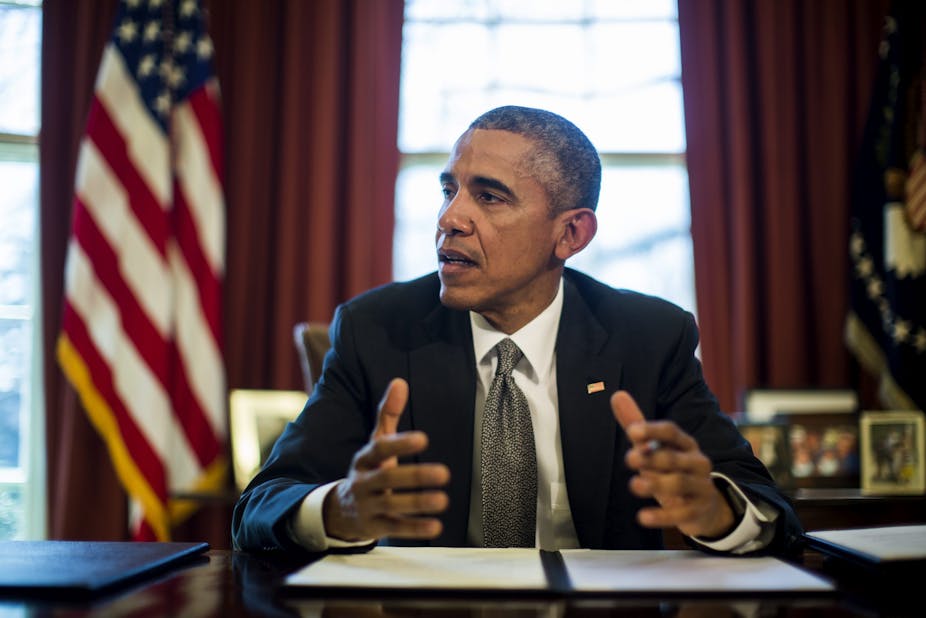The United States has formally submitted its target for a post-2020 climate deal to be negotiated in Paris at the end of 2015. The target, to reduce greenhouse gases 26-28% below 2005 levels by 2025, is the same as announced in a joint deal with China in November last year.
Australia is currently seeking submissions on a post-2020 climate target, with a formal announcement expected by mid-2015. However a discussion paper released on Saturday suggests that Australia is looking for excuses to free-ride on the efforts of other nations.
Looking for excuses
The government discussion paper comes fairly late in the international process. Some other countries, notably the US and the European Union, have already formally submitted their targets, or have provided clear statements of their intent. Global action seems to be accelerating, leaving Australia in the dust.
The discussion paper, authored by the Prime Minister’s department, has been met with widespread, scathing – and appropriate - criticism.
It reminds me of Australia’s “poor little rich kid” approach taken when negotiating our extremely generous 1997 Kyoto target, while failing to focus on the fundamental goals of global climate policy. As in 1997, it argues that Australia is “different”, so we need more generous emission targets than other countries. The discussion paper notes that Australia’s population and economic growth is stronger than other developed nations, putting upwards pressure on greenhouse gas emissions.
Yet some of the differences, such as our present high coal dependence, justify a stronger, not weaker, target. We have more scope to cut emissions than other low emission intensity countries.
The problem is that most countries can claim differences. And a high carbon Australian economy is vulnerable to the outcomes of effective actions by other countries.
The paper attempts to justify weak ambitions instead of recognising the benefits of stronger action for Australia while acknowledging the challenges. Its key flaw is that limited action before 2030 means impossibly rapid and economically disruptive emission cuts would be needed by 2050 if Australia is to play a meaningful role in limiting warming to anywhere near the 2C “climate danger” threshold.
For instance, The Climate Institute recommends cuts of 40% below 2000 levels by 2025, and 65-75% below 2000 levels by 2035. Smaller targets would require greater action beyond 2025 – if Australia sticks to an unconditional 5% below 2000 levels by 2020, emissions reductions of 9% each year are required to keep warming below 2C. But if Australia adopts the conditional target of 15% below 1990 levels by 2020, the effort required is 6.5% each year.
This doesn’t fit well with the government’s rhetoric on intergenerational fairness.
At least the paper acknowledges climate change is happening. It restates the government’s faith in its Direct Action measures, although it flags the possible need for further action such as vehicle fuel efficiency, building and appliance standards.
Australia compared
In contrast to the government’s approach, the Climate Change Authority has issued a very helpful guide to understanding the issues underlying target setting. It will also publish proposed targets based on its comprehensive approach. This will provide a far better basis for public discussion than the government’s five page paper.

While the government emphasises that certainty is important for business and policy makers, its likely post-2020 target will not provide this, because it will be completely out of step with commitments from other Parties to the United Nations Framework Convention on Climate Change. It will have to be revised in the near future. It will provide the certainty of uncertainty and confusion.
The inadequacy of the discussion paper’s aspirations will simply undermine the relevance of the Australian government to climate action within Australia and internationally. It may well provoke state and local governments and progressive businesses to step up their action and focus more on coordinated approaches.
Also banks and other financial businesses need somewhere to invest their money other than in fossil fuels, so they may build on recent developments to mobilise abatement activity.
We are already seeing state and local governments supporting new investments in renewable energy and introducing stronger energy efficiency measures. The financial community is offering finance for emission reduction projects, and shifting funds away from investments vulnerable to global climate action.
So others will fill the vacuum. But this will be less co-ordinated and certain than an effective national strategy.
At the end of the paper, the government invites submissions on our post-2020 target, the potential impacts, and possible additional policies that could complement Direct Action.
Alan will be on hand for an Author Q&A session between 2:30 and 3:30pm AEDT on Thursday April 2. Post your questions about the article in the comments section below.

